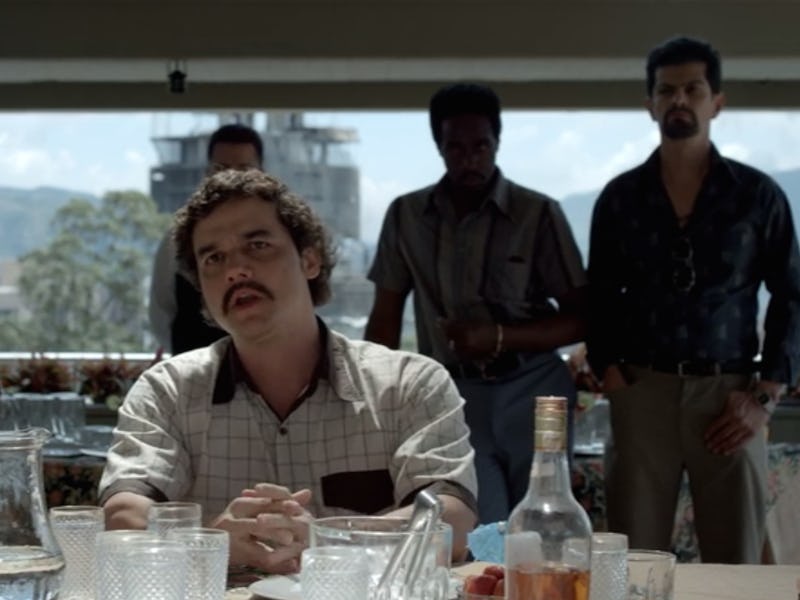'Narcos' Episode 2 Shows the Machiavellian Talents of Pablo Escobar
He consolidates power with a master class savage strategy, and it's entertaining as hell.

Partly for SEO and partly because no television critic will ever, ever get tired of talking about Breaking Bad, Netflix’s Narcos is getting a lot of description as the streaming service’s answer to the saga of Walter White. But by the show’s second episodes, “The Sword of Simon Bolivar,” it feels more like a show about the real heavyweight of Breaking Bad, Gus Fring.
Fine by me. Who could watch that scene of Fring triumphant at the cartel pool in Mexico, barely able to stand yet daring anyone left alive to challenge him, and not root for the chicken man? The Pablo Escobar of Narcos is already well beyond the point of deciding to break bad, and here we see him taking advantage of events and molding public opinion with methods that are thrillingly Machiavellian.
First, there’s the kidnapping of Martha Ochoa, sister of the Ochoa brothers, influential players in drug trafficking. The girl is kidnapped by guerrillas calling themselves M-19, disdained by our DEA-agent narrator Murphy as amateurs who read too much Marx, led by a history teacher who goes by Ivan the Terrible. The guerrillas kidnap the girl and steal the eponymous sword of Simón Bolivar, hoping to make a name for themselves.
Escobar sees opportunity. With the pretext of the kidnapping, Escobar has an excuse to unite the narcos beneath him, promising the safe return of the girl and protection from future hostility. For a nominal fee, he will run the day-to-day of this mutually beneficial arrangement, and so no one misunderstands their meaning, they will take the name “Death to Kidnappers.” Now we have Columbia’s first cocaine cartel. Salud.
Escobar delivers on his promises; a few well-publicized murders have the right effect, and the girl is released. But it’s only when he has the leader of M-19 before him that we realize how shrewdly Escobar is playing the long game. Ivan offers up Bolivar’s sword expecting to die on it. Rather than gut the man on the veranda, Escobar absorbs him into Medellín’s new cartel. If Gus Fring weren’t fictional, he’d applaud.
For whatever reason, people love to learn about work. Successful work, anyway. Donald Trump has come a long way for a sentient clown shoe by promising to reveal trade secrets in books and board games about the Art of the Deal. Obvious Narcos influence Martin Scorsese laid down 60 of his most involving minutes ever in the near-documentary opening of Casino, showing how the cash was moved from the tourist pocket to back room to a suitcase in Kansas City. Between its insights into the drug trade (when you run out of ways to launder your cash, giving it to the poor will at least buy you the people) and Escobar’s management style, Narcos in its early episodes shows promise as one of the best dramas about professionals ever made.
Meanwhile, there’s poor narrator agent Murphy, who so far hasn’t been given nearly as much to do, and whose willingness to get violent quick hasn’t given him much of a dramatic arc yet, even if this is true to the facts. Here he’s just getting into Columbia and finding that his cat would’ve been better off if he’d left it at customs.
Drug Trade History
Escobar names his newly minted cartel “Death to Kidnappers,” to take advantage of Ochoa’s kidnapping and to promise the group a measure of protection. Ironically, much of the drug trade south of the border now relies on kidnapping, especially in Mexico, where the Zeta organization has kidnapped dozens of people over the last few years, mostly engineers and technicians.
As Wired reports, the cartels aren’t doing this with the intention of ransoming the victims, but because they have the highly valuable skill set necessary to maintain the Zetas’ extensive radio network. The network allows “Hawks” to inform on the movement of rival cartels, police — anyone the Zetas would care about — via short-wave walkie-talkies to antennas, often taken from legitimate businesses, concealed on rooftops and in trees. Repeaters are rigged to amplify the signals to command-control centers concealed across the country, including elaborate setups of laptops and radio gear that would appear to be unassuming residential homes.
Authorities keep trying to dismantle or jam this nervous system, tearing down nearly 170 radio antennas in 2011 alone. Between the constant need to rebuild and repairing aging equipment, the Zetas have essentially forced what specialists they can grab into slavery, working them and then discarding them.